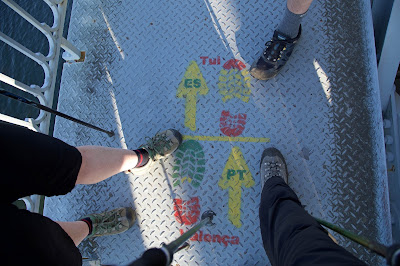“Portugal and Spain are pretty much the same,
aren’t they”?
A few friends had asked me
that question, both before and after our pilgrimage. I’d answered as diplomatically as possible that, while their
languages, histories and cultures may seem
somewhat alike, a little digging would uncover a great many differences. Not to
mention sensitivities, suspicions, even animosities. Exhibit A: Pastel de nata.
 |
A pair of irresistible pasteis de nata |
On our journey through
northern Portugal, our mid-morning ritual, wherever possible, has been to find
a coffee. And where there’s coffee, there’s invariably a small, round, egg tart
known to locals as pastel de nata.
It’s curious that something as small, simple and sweet as a glorified custard
tart can wheedle its way into your gastronomic heart. But it does. We find
ourselves anticipating nata time;
then walking on rejuvenated post nata.
 |
The signpost tells us we're nearing the Spanish border |
It all stops at the Spanish
border, and it’s not entirely clear why. Nata
were first created in Portuguese convents and monasteries. But why, I wonder,
not Spanish ones? It’s such a felicitous way to use up excess egg yolks after you’ve
employed the egg whites to starch your habits. Apart from this mysterious
culinary divide, it’s also a reminder of the deep influence religion has had on
the Iberian peninsula.
 |
Crosses punctuate the sky throughout Spain & Portugal |
During our slow walk through
the countryside we find eternity rehearsed in the many churches, crosses,
customs and devotional sites we pass. We notice too the periodic bong of church bells, tracking the
passage of time so much more deeply than the tick of watches or clocks. That sound feels like a landscape-wide assertion
that the here-and-now is joined to the forever.
We wonder whether we even see
the moral tug of eternity in the kindness of some Portuguese. In just one
instance, as we’re wearily working our way through the sweltering semi-industrial
outskirts of Valenca, we inadvertently walk past a yellow arrow. As we
heedlessly head off in the wrong direction, a passing driver is quick to assess
our situation. He stops, turns his car around, drives back to tell us we’ve
gone a few hundred metres past our “way”, and puts us back on track with a
smile and a wave.
 |
Fortaleza de Valenca, Portugal, facing Spain |
Valenca is to be our final
Portuguese town. Once we walk across the Minho River, we’ll be in Spain. There
we’ll encounter a new language; different customs; and a myriad subtle changes.
Bom dia will become Buenos dias, and we’ll have leche in our coffee rather than leite. Sadly it’ll also be farewell to nata.
Of course it’s not just the
loss of tarts that creates a sense of drama at the border. Valenca is an old fort
town dating back to Roman times. Its bland modernisation can’t hide its
impessive old fortification, the Forteleza
de Valenca, perched high above the banks of the Minho. We spend our last Portuguese
night in the old fort town. It’s a beautiful warm afternoon, and a perfect
setting for our last coffee and pastel de
nata.
 |
Our final pastel de nata in Valenca |
The large fort, with its
thick cannon-topped walls facing Spain, was built to impress, intimidate and
keep-a-good-eye-on those on the other side of the Minho. For us it offers a
grandstand view over Spain. We dine al
fresco, watching a sunset seemingly turned on for our farewell.
 |
Farewell sunset from Valenca, Portugal |
We’re back there in the
morning, but this time to take our leave. Our way takes us through the old city
and down to the bridge over the Minho. How many feet, in war and in peace, have
marched down that steep cobbled lane, passed under that wall and gone through
that city gate?
 |
Leaving Valenca through the city gate |
We feel a strange
reluctance to leave. We pause to take farewell photos, and stop at the “border”,
a painted line half way over the bridge. Finally we finish crossing the Minho
and climb up into the town of Tui. It’s time to say Hola Espagna!
 |
The border crossing on the Minho bridge |
No comments:
Post a Comment